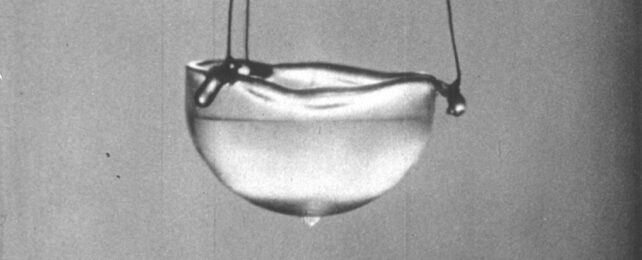 Superfluid helium looks like a simple transparent liquid, but its behavior is incredibly complex. (AlfredLeitner/Wikimedia Commons, public domain)
Superfluid helium looks like a simple transparent liquid, but its behavior is incredibly complex. (AlfredLeitner/Wikimedia Commons, public domain)An experiment has finally revealed how it might feel to touch a quantum superfluid.
Physicists dunked a special, finger-sized probe into an isotope of helium cooled to just a smidge over absolute zero, and recorded the physical properties therein.
It is, they say, the first time we have gleaned an inkling of what the quantum Universe might feel like. And no one had to get horrific frostbite, or ruin an experiment, to find out for real.
"In practical terms, we don't know the answer to the question 'how does it feel to touch quantum physics?'," says physicist Samuli Autti of Lancaster University in the UK, who led the research.
"These experimental conditions are extreme and the techniques complicated, but I can now tell you how it would feel if you could put your hand into this quantum system. Nobody has been able to answer this question during the 100-year history of quantum physics. We now show that, at least in superfluid 3He, this question can be answered."
Superfluids are a state of matter that behave like a fluid with zero viscosity or friction. There are two isotopes of helium that can create a superfluid. When cooled to just above absolute zero (−273.15 degrees Celsius or −459.67 degrees Fahrenheit), bosons of the helium-4 isotope slow down enough to overlap into a high-density cluster of atoms that behave like one super-atom.
Helium-3 is a little different. Its nuclei are fermions, a class of particles that spin differently from bosons. When cooled below a certain temperature, fermions become bound together in what are called Cooper pairs, each made up of two fermions that together form a composite boson. These Cooper pairs behave exactly like bosons, and can thus form a superfluid.
Autti and his team have been experimenting with helium-3 fermionic superfluid for some time, and discovered that, although Cooper pairs are quite fragile, researchers can stick a wire inside without breaking the pairs, or even disrupting the superfluid's flow. So the team decided to design a probe to study the properties of the fluid up close and personal.
And, well, it's kind of really weird. The surface of the fluid seems to form an independent two-dimensional layer that transports heat away from the rod. The bulk of the superfluid underneath it acts almost like a vacuum; it's entirely passive and doesn't feel like anything at all, the researchers found.
The only part of the fluid that interacted with the probe was that two-dimensional surface layer. The bulk only becomes accessible if a huge burst of energy is imparted into it. The thermomechanical properties of the superfluid are entirely defined by that two-dimensional layer.
"This liquid would feel two-dimensional if you could stick your finger into it. The bulk of the superfluid feels empty, while heat flows in a two-dimensional subsystem along the edges of the bulk – in other words, along your finger," Autti says.
"This also redefines our understanding of superfluid [Helium-3]. For the scientist, that may be even more influential than hands-in quantum physics."
The implications, the researchers say, are profound. Helium-3 superfluid is the purest known material, and as such is of intense scientific interest for the study of collective matter states such as superfluids. Understanding how its two-dimensional layer behaves could shed light on quasiparticle behavior, topological defects, and quantum energy states.
"These research avenues," the researchers write, "have the potential to transform our understanding of this versatile macroscopic quantum system."
The research is due to appear in Nature Communications, and is available on arXiv.
0 Comments